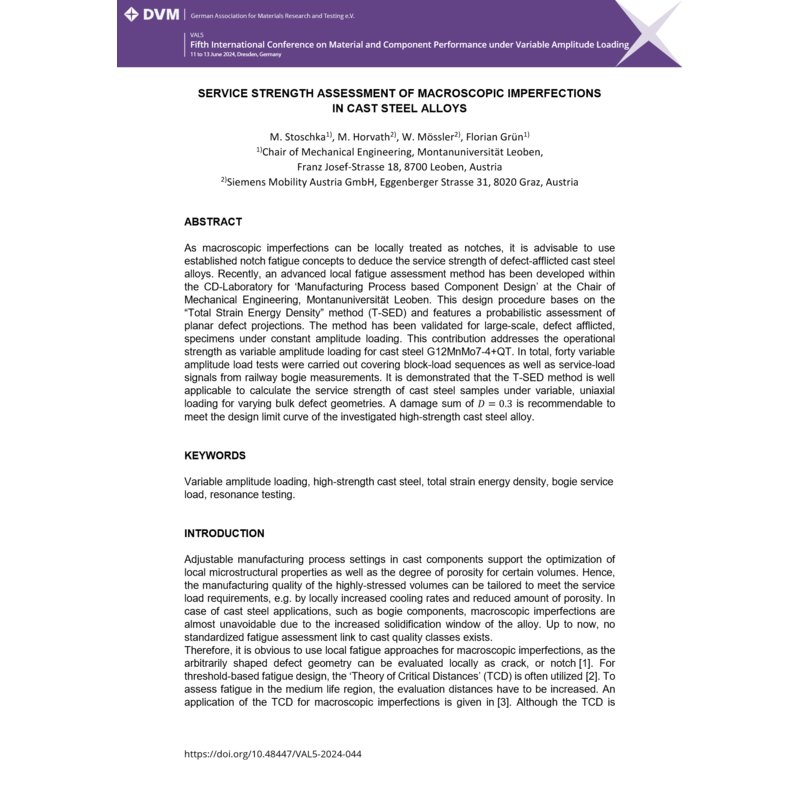- Online only



Adjustable manufacturing process settings in cast components support the optimization of local microstructural properties as well as the degree of porosity for certain volumes. Hence, the manufacturing quality of the highly-stressed volumes can be tailored to the meet the service load requirements, e.g. by locally increased cooling rates and reduced amount of porosity. In case of cast steel applications, such as bogie components, macroscopic imperfections are almost unavoidable due to the increased solidification window of the alloy.
The fatigue assessment of engineering components is often guided by the FKM guideline, which features only a generalized casting factor. This material safety factor considers thereby unavoidable, but allowable, macroscopic imperfections as spatial…

Datenschutzbedingungen (bearbeiten im Modul "Kundenvorteile")

Lieferbedingungen (bearbeiten im Modul "Kundenvorteile")

Rücksendebedingungen (bearbeiten im Modul "Kundenvorteile")
Adjustable manufacturing process settings in cast components support the optimization of local microstructural properties as well as the degree of porosity for certain volumes. Hence, the manufacturing quality of the highly-stressed volumes can be tailored to the meet the service load requirements, e.g. by locally increased cooling rates and reduced amount of porosity. In case of cast steel applications, such as bogie components, macroscopic imperfections are almost unavoidable due to the increased solidification window of the alloy.
The fatigue assessment of engineering components is often guided by the FKM guideline, which features only a generalized casting factor. This material safety factor considers thereby unavoidable, but allowable, macroscopic imperfections as spatial defects in castings. Up to now, no standardized fatigue assessment links to cast quality classes. Therefore, an advanced local fatigue assessment method has been recently developed within the CD-Laboratory for ‘Manufacturing Process based Component Design’ at the Chair of Mechanical Engineering, Montanuniversität Leoben. This design procedure bases on the “Total Strain Energy Density” method (T-SED) and features a probabilistic assessment of planar defect projections [1-3]. The method has been calibrated on notched small-scale fatigue samples and successfully validated for large-scale, defect afflicted, specimen under constant amplitude loading (CAL).
This paper contributes results of variable amplitude loading (VAL) tests of cast steel specimen with arbitrary shaped, macroscopic imperfections. It was found that the elasto-plastic T-SED based design limit curve is well applicable to variable load conditions, both for changes in stress amplitude and stress ratio, as the accumulated total strain energy density within the control volume for each point of the defect contour inherits the elasto-plastic deformation behaviour. To obtain an equivalent T-SED design value ΔWeqt in case of variable amplitude load blocks, the equivalent T-SED is calculated similarly to Niemi’s approach for random loading of welded components. The inverse slope values of the T-SED design curve differ from stress-based fatigue, in the finite life region a slope value of k1=2.5 and in case of high-cycle-fatigue a value of k2=12.5 is applicable for cast steel alloy G12MnMo7-4+QT. These slope values are derived from constant amplitude loading tests of small-scale specimen, but are also applicable to large-scale specimen with bulk-volume casting defects. In the equation, subscript i refers to the energy values above the knee point , subscript j references the total strain energy values below. The knee point is denoted by index k. First fatigue results of cast steel G12MnMo7-4+QT indicate an applicable damage sum of D=0.5 to calculate the equivalent total strain energy density.
The calculated T-SED equivalence values for some defect-afflicted large-scale cast steel specimen are sketched into the design limit curve, indicating the suitability of the T-SED method to assess the service strength of cast steel imperfections under variable amplitude load. In addition, a light optical microscopy of the fracture surface depicts the macroscopic imperfection within the cross-section of the large-scale specimen. Finally, the crack growth under variable amplitude loading is shown by scanning electron microscopy for a load sequence of seven blocks, which comprise alterations in stress range from ΔS=75MPa to 300MPa and stress ratio between R=-1 and up to 0.7. Further VAL tests are currently ongoing and aim to proof, a.) the applicability of the elasto-plastic T-SED design method for other load sequences for G12MnMo7-4+QT, b.) validate the service strength assessment for cast steel alloy G21Mn5+N.